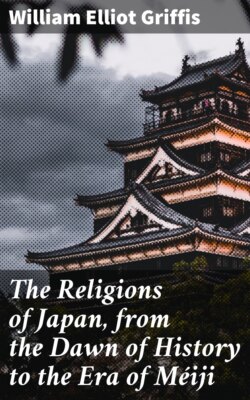Читать книгу The Religions of Japan, from the Dawn of History to the Era of Méiji - William Elliot Griffis - Страница 13
На сайте Литреса книга снята с продажи.
The People of Japan.
ОглавлениеTable of Contents
In this faith then, in the spirit of Him who said, "I come not to destroy but to fulfil," let us cast our eyes upon that part of the world where lies the empire of Japan with its forty-one millions of souls. Here we have not a country like India—a vast conglomeration of nations, languages and religions occupying a peninsula itself like a continent, whose history consists of a stratification of many civilizations. Nor have we here a seemingly inert mass of humanity in a political structure blending democracy and imperialism, as in China, so great in age, area and numbers as to weary the imagination that strives to grasp the details. On the contrary, in Dai Nippon, or Great Land of the Sun's Origin, we have a little country easy of study. In geology it is one of the youngest of lands. Its known history is comparatively modern. Its area roughly reckoned as 150,000 square miles, is about that of our Dakotas or of Great Britain and Ireland. The census completed December 31, 1892, illustrates here, as all over the world, nature's argument against polygamy. It tells us that the relation between the sexes is, numerically at least, normal. There were 20,752,366 males and 20,337,574 females, making a population of 41,089,940 souls. All these people are subjects of the one emperor, and excepting fewer than twenty thousand savages in the northern islands called Ainos, speak one language and form substantially one race. Even the Riu Kiu islanders are Japanese in language, customs and religion. In a word, except in minor differences appreciable or at least important only to the special student, the modern Japanese are a homogeneous people.
In origin and formation, this people is a composite of many tribes. Roughly outlining the ethnology of Japan, we should say that the aborigines were immigrants from the continent with Malay reinforcement in the south, Koreans in the centre, and Ainos in the east and north, with occasional strains of blood at different periods from various parts of the Asian mainland. In brief, the Japanese are a very mixed race. Authentic history before the Christian era is unknown. At some point of time, probably later than A.D. 200, a conquering tribe, one of many from the Asian mainland, began to be paramount on the main island. About the fourth century something like historic events and personages begin to be visible, but no Japanese writings are older than the early part of the eighth century, though almanacs and means of measuring time are found in the sixth century. Whatever Japan may be in legend and mythology, she is in fact and in history younger than Christianity. Her line of rulers, as alleged in old official documents and ostentatiously reaffirmed in the first article of the constitution of 1889, to be "unbroken for ages eternal," is no older than that of the popes. Let us not think of Aryan or Chinese antiquity when we talk of Japan. Her history as a state began when the Roman empire fell. The Germanic nations emerged into history long before the Japanese.
Roughly outlining the political and religious life of the ancient Japanese, we note that their first system of government was a rude sort of feudalism imposed by the conquerors and was synchronous with aboriginal fetichism, nature worship, ancestral sacrifices, sun-worship and possibly but not probably, a very rude sort of monotheism akin to the primitive Chinese cultus.9 Almost contemporary with Buddhism, its introduction and missionary development, was the struggle for centralized imperialism borrowed from the Chinese and consolidated in the period from the seventh to the twelfth century. During most of this time Shint[=o], or the primitive religion, was overshadowed while the Confucian ethics were taught. From the twelfth to this nineteenth century feudalism in politics and Buddhism in religion prevailed, though Confucianism furnished the social laws or rules of daily conduct. Since the epochal year of 1868, with imperialism reestablished and the feudal system abolished, Shint[=o] has had a visible revival, being kept alive by government patronage. Buddhism, though politically disestablished, is still the popular religion with recent increase of life,10 while Confucianism is decidedly losing force. Christianity has begun its promising career.
